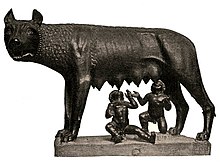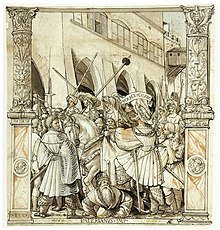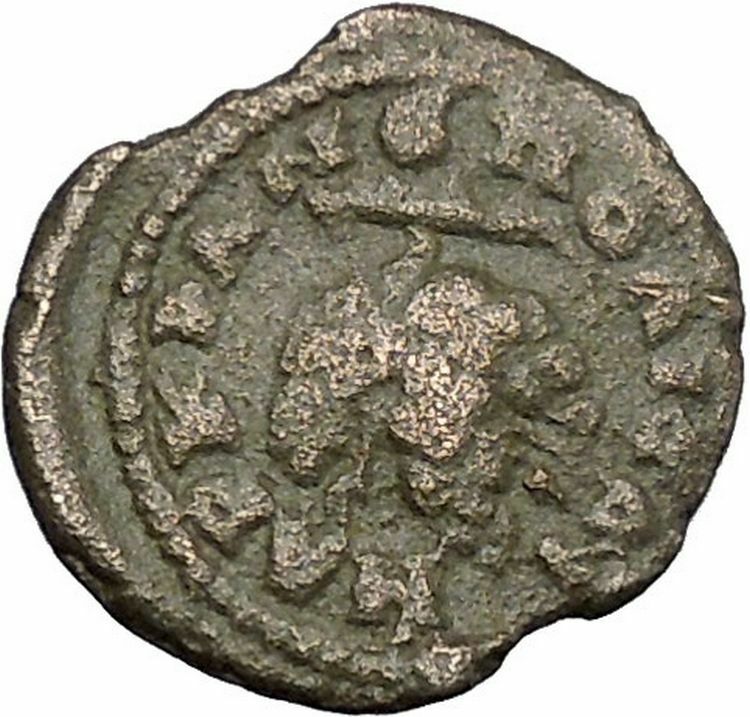|
Valerian I – Roman Emperor: 253-260 A.D.
Bronze 21mm (3.51 grams) of Alexandria Troas in Troas
Reference: Bellinger A442 var.; SNG Copenhagen 187 var.; SNG von Aulock -; BMC 167
IMP LIC VALERIANVS AVG, Laureate, draped and cuirassed bust right.
COL AVG TRO, ‘Lupa Romana’ Capitoline She-Wolf suckling Romulus and Remus, the founding twins of Rome.
You are bidding on the exact item pictured, provided with a Certificate of Authenticity and Lifetime Guarantee of Authenticity.
 Romulus and Remus are Rome’s twin founders in its traditional foundation myth. They are descendants of the Trojan prince and refugee Aeneas, and are fathered by the god Mars or the demi-god Hercules on a royal Vestal Virgin, Rhea Silvia, whose uncle exposes them to die in the wild. They are found by a she-wolf who suckles and cares for them. The twins are eventually restored to their regal birthright, acquire many followers and decide to found a new city. Romulus and Remus are Rome’s twin founders in its traditional foundation myth. They are descendants of the Trojan prince and refugee Aeneas, and are fathered by the god Mars or the demi-god Hercules on a royal Vestal Virgin, Rhea Silvia, whose uncle exposes them to die in the wild. They are found by a she-wolf who suckles and cares for them. The twins are eventually restored to their regal birthright, acquire many followers and decide to found a new city.
Romulus wishes to build the new city on the Palatine Hill; Remus prefers the Aventine Hill. They agree to determine the site through augury. Romulus appears to receive the more favourable signs but each claims the results in his favour. In the disputes that follow, Remus is killed. Ovid has Romulus invent the festival of Lemuria to appease Remus’ resentful ghost. Romulus names the new city Rome, after himself, and goes on to create the Roman Legions and the Roman Senate. He adds citizens to his new city by abducting the women of the neighboring Sabine tribes, which results in the combination of Sabines and Romans as one Roman people. Rome rapidly expands to become a dominant force, due to divine favour and the inspired administrative, military and political leadership of Romulus. In later life Romulus becomes increasingly autocratic, disappears in mysterious circumstances and is deified as the god Quirinus, the divine persona of the Roman people.
The legend of Romulus and Remus encapsulates Rome’s ideas of itself, its origins, moral values and purpose: it has also been described as one of the most problematic of all foundation myths. Romulus’ name is thought to be a back-formation from the name Rome; Remus’ is a matter for ancient and modern speculation. The main sources for the legend approach it as history and offer an implausibly exact chronology: Roman historians dated the city’s foundation variously from 758 to 728 BC. Plutarch says Romulus was fifty-three at his death; which reckoning gives the twins’ birth year as c. 771 BC. Possible historical bases for the broad mythological narrative remain unclear and much disputed. Romulus and Remus are eminent among the feral children of ancient mythography.
Alexandria Troas (“Alexandria of the Troad“, mod. Eski Stambul) is an ancient Greek city situated on the Aegean Sea near the northern tip of Turkey’s western coast, a little south of Tenedos (modern Bozcaada). It is located in the modern Turkish province of Çanakkale.
According to the Catholic Encyclopedia, this site was first called Sigia; perhaps about 310 BC Antigonus refounded the city as Antigonia Troas. In its early years, Troas was a port city that supplied the Dorians with resources and trade. The city was conquered by the Helladic people and was nearly destroyed. It was rebuilt early in the next century and the name was changed by Lysimachus to Alexandria Troas, in memory of Alexander III of Macedon (Pliny, N.H. 5.124 merely states that the name changed from Antigonia to Alexandria). As the chief port of north-west Asia Minor, the place prospered greatly in Roman times, and the existing remains sufficiently attest its former importance. Strabo mentions that a Roman colony was created at the location in the reign of Augustus, named Colonia Alexandria Augusta Troas (called simply Troas during this period). Augustus, Hadrian and the rich grammarian Herodes Atticus contributed greatly to its embellishment; the aqueduct still preserved is due to the latter. Constantine considered making Troas the capital of the Roman Empire.
In Roman times, it was a significant port for travelling between Anatolia and Europe. Paul of Tarsus sailed for Europe for the first time from Alexandria Troas (Acts, 16:8-11) and returned there from Europe (and there occurred later the episode of the raising of Eutychus (Acts 20:5-12). Ignatius of Antioch also paused at this city before continuing to his martyrdom at Rome (Ad Philad. 11.2; Ad Smyrn. 12.1).
Several of its later bishops are known: Marinus in 325; Niconius in 344; Sylvanus at the beginning of the fifth century; Pionius in 451; Leo in 787; Peter, friend of the Patriarch Ignatius, and adversary to Michael, in the ninth century. In the tenth century Troas is given as a suffragan of Cyzicus and distinct from the famous Troy (Heinrich Gelzer, Ungedruckte … Texte der Notitiae episcopatuum, 552; Georgii Cyprii descriptio orbis romani, 64); it is not known when the city was destroyed and the diocese disappeared. The city remains a titular see of the Roman Catholic Church, Troadensis; the seat is vacant following the resignation of the last bishop in 1971. Troas is also a titular see of the Orthodox Church under the Ecumenical Patriarchate; the current hierarch is His Grace Bishop Savas (Zembillas) of Troas.
The site as of 1911 was covered with vallonea oaks, and has been much plundered (for example Mehmed IV took columns to adorn his new Valideh mosque in Istanbul), but the circuit of the old walls can be traced, and in several places they are fairly well preserved. They had a circumference of about ten kilometres, and were fortified with towers at regular intervals. Remains of some ancient buildings, including a bath and gymnasium, can be found within this area. Trajan built an aqueduct which can still be traced. The harbour had two large basins, now almost choked with sand. It is the subject of a recent study by German archaeologists who are digging and surveying at the site.
Valerian I – Augustus: A.D. 253-260 with Gallienus
Husband of Mariniana | Father of Gallienus | Grandfather of Valerian II and Saloninus

Publius Licinius Valerianus (c. 200 – after 260), commonly known in English as Valerian or Valerian I, was the Roman Emperor from 253 to 260.
Unlike the majority of the pretenders during the Crisis of the Third Centuryy, Valerian was of a noble and traditional senatorial family. Details of his early life are elusive, but for his marriage to Egnatia Mariniana, who gave him two sons: later emperor Publius Licinius Egnatius Gallienus and Valerianus Minor.
In 238 he was princeps senatus, and Gordian I negotiated through him for Senatorial acknowledgement for his claim as emperor. In 251, when Decius revived the censorship with legislative and executive powers so extensive that it practically embraced the civil authority of the emperor, Valerian was chosen censor by the Senate, though he declined to accept the post. Under Decius he was nominated governor of the Rhine provinces of Noricum and Raetia and retained the confidence of his successor, Trebonianus Gallus, who asked him for reinforcements to quell the rebellion of Aemilianus.
Rule and fall
Valerian’s first act as emperor was to make his son Gallienus his colleague. In the beginning of his reign the affairs in Europe went from bad to worse and the whole West fell into disorder. In the East, Antioch had fallen into the hands of a Sassanid vassal, Armenia was occupied by Shapur I (Sapor). Valerian and Gallienus split the problems of the empire between the two, with the son taking the West and the father heading East to face the Persian threat.
By 257, Valerian had already recovered Antioch and returned the province of Syria to Roman control but in the following year, the Goths ravaged Asia Minor. Later in 259, he moved to Edessa, but an outbreak of plague killed a critical number of legionaries, weakening the Roman position in Edessa which was then besieged by the Persians. At the beginning of 260, Valerian was defeated in the Battle of Edessa and he arranged a meeting with Shapur to negotiate a peace settlement. The ceasefire was betrayed by Shapur who seized him and held him prisoner for the remainder of his life. Valerian’s capture was a humiliating defeat for the Romans.
Gibbon, in The History of the Decline and Fall of the Roman Empire describes Valerian’s fate:
The voice of history, which is often little more than the organ of hatred or flattery, reproaches Sapor with a proud abuse of the rights of conquest. We are told that Valerian, in chains, but invested with the Imperial purple, was exposed to the multitude, a constant spectacle of fallen greatness; and that whenever the Persian monarch mounted on horseback, he placed his foot on the neck of a Roman emperor. Notwithstanding all the remonstrances of his allies, who repeatedly advised him to remember the vicissitudes of fortune, to dread the returning power of Rome, and to make his illustrious captive the pledge of peace, not the object of insult, Sapor still remained inflexible. When Valerian sunk under the weight of shame and grief, his skin, stuffed with straw, and formed into the likeness of a human figure, was preserved for ages in the most celebrated temple of Persia; a more real monument of triumph, than the fancied trophies of brass and marble so often erected by Roman vanity. The tale is moral and pathetic, but the truth of it may very fairly be called in question. The letters still extant from the princes of the East to Sapor are manifest forgeries; nor is it natural to suppose that a jealous monarch should, even in the person of a rival, thus publicly degrade the majesty of kings. Whatever treatment the unfortunate Valerian might experience in Persia, it is at least certain that the only emperor of Rome who had ever fallen into the hands of the enemy, languished away his life in hopeless captivity.
Valerian’s massacre of 258
According to the Catholic Encyclopedia article on Valerian:
Pope Sixtus was seized on 6 August, 258, in one of the Catacombs and was put to death; Cyprian of Carthage suffered martyrdom on 14 September. Another celebrated martyr was the Roman deacon St. Lawrence. In Spain Bishop Fructuosus of Tarragona and his two deacons were put to death on 21 January, 259. There were also executions in the eastern provinces (Eusebius, VII, xii). Taken altogether, however, the repressions were limited to scattered spots and had no great success..
Death in captivity
An early Christian source, Lactantius, maintained that for some time prior to his death Valerian was subjected to the greatest insults by his captors, such as being used as a human footstool by Shapur when mounting his horse. According to this version of events, after a long period of such treatment Valerian offered Shapur a huge ransom for his release. In reply, according to one version, Shapur was said to have forced Valerian to swallow molten gold (the other version of his death is almost the same but it says that Valerian was killed by being flayed alive) and then had the unfortunate Valerian skinned and his skin stuffed with straw and preserved as a trophy in the main Persian temple. It was further alleged by Lactantius that it was only after a later Persian defeat against Rome that his skin was given a cremation and burial. The role of a Chinese prince held hostage by Shapur I, in the events following the death of Valerian has been frequently debated by historians, without reaching any definitive conclusion.

The Humiliation of Emperor Valerian by Shapur I, pen and ink, Hans Holbein the Younger, ca. 1521
Some modern scholars believe that, contrary to Lactantius’ account, Shapur I sent Valerian and some of his army to the city of Bishapur where they lived in relatively good condition. Shapur used the remaining soldiers in engineering and development plans. Band-e Kaisar (Caesar’s dam) is one of the remnants of Roman engineering located near the ancient city of Susa. In all the stone carvings on Naghshe-Rostam, in Iran, Valerian is respected by holding hands with Shapur I, in sign of submission.
It is generally supposed that some of Lactantius’ account is motivated by his desire to establish that persecutors of the Christians died fitting deaths; the story was repeated then and later by authors in the Roman Near East “fiercely hostile” to Persia.
Other modern scholars tend to give at least some credence to Lactantius’ account.
Valerian and Gallienus’ joint rule was threatened several times by usurpers. Despite several usurpation attempts, Gallienus secured the throne until his own assassination in 268.
Owing to imperfect and often contradictory sources, the chronology and details of this reign are very uncertain.
|




 Romulus and Remus are Rome’s twin founders in its traditional foundation myth. They are descendants of the Trojan prince and refugee Aeneas, and are fathered by the god Mars or the demi-god Hercules on a royal Vestal Virgin, Rhea Silvia, whose uncle exposes them to die in the wild. They are found by a she-wolf who suckles and cares for them. The twins are eventually restored to their regal birthright, acquire many followers and decide to found a new city.
Romulus and Remus are Rome’s twin founders in its traditional foundation myth. They are descendants of the Trojan prince and refugee Aeneas, and are fathered by the god Mars or the demi-god Hercules on a royal Vestal Virgin, Rhea Silvia, whose uncle exposes them to die in the wild. They are found by a she-wolf who suckles and cares for them. The twins are eventually restored to their regal birthright, acquire many followers and decide to found a new city.






